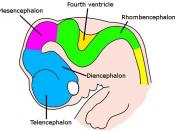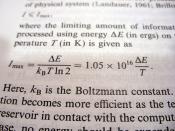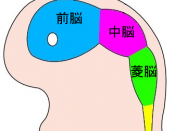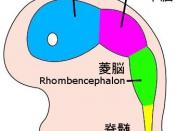Bottom-up processing is the analysis that begins with the sense receptors and works up to the brain's integration of sensory information. It describes the work of sensory receptors that change stimuli into neural messages that most usually reaches the brain. Sensation is the process by which our sensory receptors and nervous system receives stimulus energies from our environment. Bottom-up processing is akin to sensation.
An example of bottom up processing occurs in vision. Bottom-up processing beings with transduction, which is the conversion of stimulus energy into neural impulses. The stimulus energy is in the form of light energy (waves), and this light energy enters the eye. After passing through such parts as the iris and the lens, the light energy reaches the retina, where sense receptors are located and where transduction occurs. Rods and cones are the eye's sense receptors that produce chemical changes that generate neural signals. These neural signals get relayed to the optic nerve, which leads to the brain.
Another example of bottom-up processing is that which occurs in hearing. Like vision, the stimulus energy that enters the ears is in the form of waves. These sound waves travel through the outer, middle and inner ear until they finally vibrate the basilar membrane. The hair cells on this membrane trigger impulses in nerve fibers that form the auditory nerve that relays this information to the brain.
Top-down processing is the information processing guided by higher-level mental processes, as when we construct perceptions drawing on our experience and expectations. Top down processing is the mind interpreting what our senses detect. Without top-down processing, one would be able to see someone's face, but not recall that person's name or remember him or her. This processing is akin to perception, which is the process of organizing and interpreting sensory information. Top-down processing is especially important in the "interpretation" aspect of perception, as our past experiences and expectations could lead us to interpret information in a certain way.
An example of top-down processing is the brain's integration of past experiences into vision. As the neural signals pass through the temporal and parietal cortex, they pass through higher-level brain cells that respond to certain visual scenes. These higher-level cells could be specialized in biologically important objects or events. For example, there are nerve cells that respond to a certain gaze. All other higher-cell clusters integrate their information and fire. With this collective information, instant analysis could occur. This helps a goalie detect what direction the football is going to move. As one can see, the brain integrates past experience of what a certain gaze or leg position meant into helping the goalie predict where the ball was going to go.
Another example of top-down processing in vision is vivid in the Gestalt ideas of grouping. Grouping is the perceptual tendency to organize stimuli into coherent groups. This is an example of top-down processing, as it incorporates what we expect in our perception of an image. The various tendencies that our brain has are proximity, similarity, continuity, closure and connectedness. Using the rules of closure, we would interpret particularly arranged dashed-lines as a whole triangle, rather than singular lines.







Descriptive
This describes the basic details of bottom up and top down and the points are very clear but including case studies could have gave it more strength, excellent description though.
1 out of 1 people found this comment useful.